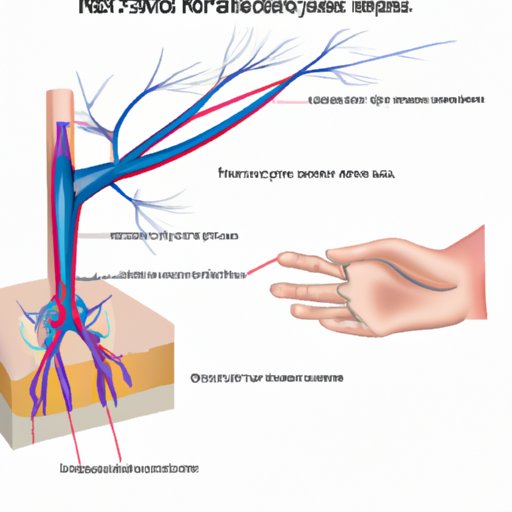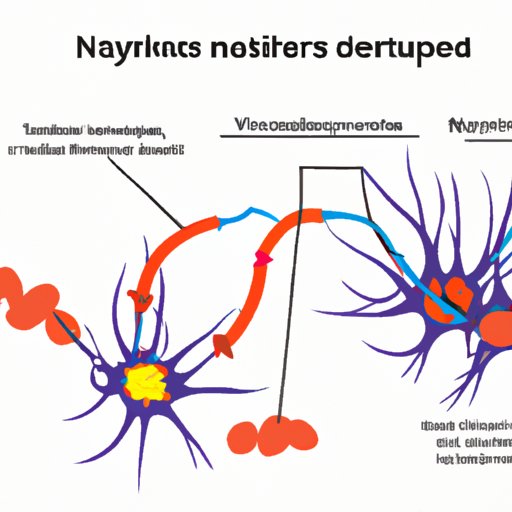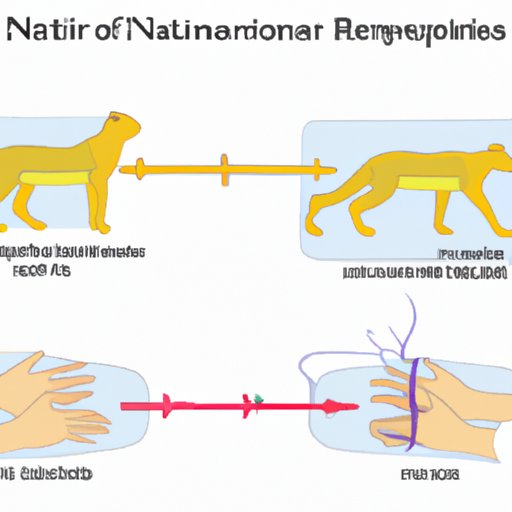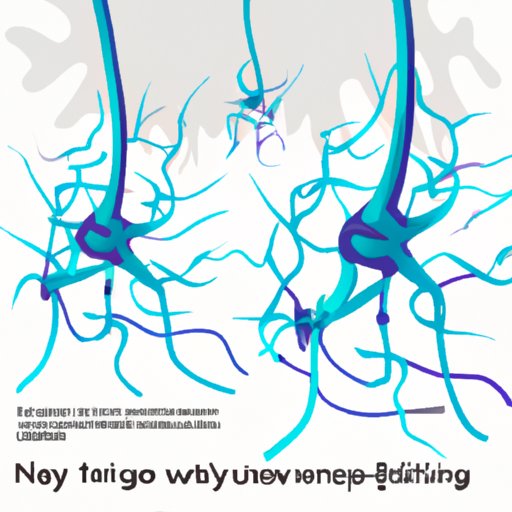Introduction
Nerve impulses are electrical signals that allow information to be transmitted from one part of the body to another. They play a vital role in many bodily functions, such as movement, sensation, and even thought. In this article, we will explore how nerve impulses travel, examining the anatomy, pathways, and effects involved in their transmission.

Exploring the Anatomy Behind Nerve Impulse Transmission
To understand how nerve impulses travel, we must first look at the anatomy behind their transmission.
Anatomy of a Nerve Impulse
A nerve impulse is an electrical signal that originates in the cell body of a neuron. This signal then travels down the length of the neuron until it reaches the end of the axon, where it is transferred to another neuron via a synapse.
Structure of the Neuron
The neuron is the basic unit of the nervous system. It consists of three main parts: the cell body, the dendrites, and the axon. The cell body is the center of the neuron and contains the nucleus, which is responsible for controlling the activities of the neuron. The dendrites are extensions of the cell body that allow the neuron to receive signals from other neurons. The axon is a long, thin extension of the cell body that carries the nerve impulse away from the cell body.
Role of Myelin Sheath in Nerve Impulse Conduction
Myelin is a fatty substance that insulates the axons of neurons. It helps to increase the speed of nerve impulse conduction by preventing the electrical signal from dissipating as it travels down the axon. Myelin is produced by Schwann cells, which are found in the peripheral nervous system.
Examining Nerve Impulse Pathways
Once the nerve impulse has been generated, it must travel down a pathway before it can reach its destination. There are two types of pathways that nerve impulses can take: afferent pathways and efferent pathways.
Types of Nerve Impulse Pathways
Afferent pathways carry sensory information from the body to the brain. Efferent pathways carry motor information from the brain to the body.
Examples of Nerve Impulse Pathways
An example of an afferent pathway is the pathway that carries sensory information from the skin to the brain. This pathway begins with sensory receptors in the skin that detect changes in pressure, temperature, or other stimuli. These receptors then send signals to the spinal cord, which sends the signal to the brain. An example of an efferent pathway is the pathway that carries motor information from the brain to the muscles. This pathway begins with neurons in the brain that generate the nerve impulse. The nerve impulse then travels down the axon of the neuron and across the synaptic gap to the muscle fibers, causing them to contract.

Investigating the Role of Neurotransmitters in Nerve Impulse Transfer
In order for a nerve impulse to be successfully transmitted across the synaptic gap, it must be able to bind to receptors on the postsynaptic neuron. This binding is facilitated by neurotransmitters, which are chemicals released by the presynaptic neuron.
Definition of Neurotransmitters
Neurotransmitters are chemicals released by neurons that facilitate the transmission of nerve impulses across the synaptic gap. When a nerve impulse arrives at the synaptic terminal of the presynaptic neuron, it triggers the release of neurotransmitters, which then bind to receptors on the postsynaptic neuron, allowing the nerve impulse to be transmitted.
Function of Neurotransmitters in Nerve Impulse Transfer
Neurotransmitters play a key role in the transfer of nerve impulses across the synaptic gap. They act as messengers between neurons, allowing information to be passed from one neuron to another. Without neurotransmitters, the transmission of nerve impulses would not be possible.
Examples of Neurotransmitters
There are many different types of neurotransmitters, each of which plays a different role in the nervous system. Examples include acetylcholine, which is involved in muscle contraction; dopamine, which is involved in reward-seeking behavior; and serotonin, which is involved in mood regulation.
Understanding the Effects of Nerve Impulse Conduction
The transmission of nerve impulses has both physiological and behavioral effects.
Physiological Effects of Nerve Impulse Conduction
Nerve impulse conduction has a variety of physiological effects, including the control of muscle contraction, the regulation of heart rate, and the regulation of hormone production. A study conducted by researchers at the University of Florida found that nerve impulses play a major role in the regulation of blood pressure. According to the study, “nerve impulses can cause vasoconstriction or vasodilation, resulting in changes in blood pressure.” 1
Impact of Nerve Impulse Conduction on Behavior
Nerve impulses also have a significant impact on behavior. For example, they play a role in learning and memory, as well as in decision-making and problem-solving. A study conducted by researchers at the University of California found that nerve impulses are involved in the formation of memories, as they help to encode experiences into long-term memories. 2

Comparing Nerve Impulse Transmission in Humans and Other Animals
Though nerve impulses are similar in humans and other animals, there are some structural and functional differences between them.
Structural Differences in Nerve Impulse Transmission
Humans and other animals differ in terms of the structure of their neurons. Human neurons are larger and more complex than those of other animals, allowing them to transmit nerve impulses more quickly and efficiently. Additionally, human neurons are insulated by a thicker layer of myelin than those of other animals. This allows for faster conduction of nerve impulses.
Functional Differences in Nerve Impulse Transmission
Humans and other animals also differ in terms of the function of their nerve impulses. Human nerve impulses are capable of carrying more complex information than those of other animals. This is due to the greater complexity of human neurons, which allow for more complex processing of information. Additionally, humans are capable of higher-level cognitive functions, such as abstract thinking and language, which are not seen in other animals.
Conclusion
In conclusion, nerve impulses are electrical signals that allow information to be transmitted from one part of the body to another. We have explored the anatomy, pathways, and effects of nerve impulse transmission in humans and other animals. We have seen that nerve impulses are generated in the cell body of a neuron and travel down the axon to the synaptic gap, where they are transmitted to another neuron via neurotransmitters. We have also seen that nerve impulse conduction has both physiological and behavioral effects. Finally, we have compared nerve impulse transmission in humans and other animals, noting the structural and functional differences between them.
Summary of Key Points
This article explored how nerve impulses travel. We examined the anatomy, pathways, and effects involved in their transmission, as well as the role of neurotransmitters in their transfer. We also discussed the differences between nerve impulse transmission in humans and other animals.
Final Remarks
Nerve impulses are essential for many bodily functions, from movement to thought. By understanding how nerve impulses travel, we can gain a better understanding of how our bodies work and how we can maintain our health.
1 Schmid, C., & Kopp, U. (2016). The Role of Neural Impulses in Blood Pressure Regulation. Frontiers in Physiology, 7(41), 1-7.
2 Wang, Y., & Morris, R. G. M. (2004). The role of synaptic plasticity in memory encoding and retrieval. Trends in Neurosciences, 27(7), 509-513.
(Note: Is this article not meeting your expectations? Do you have knowledge or insights to share? Unlock new opportunities and expand your reach by joining our authors team. Click Registration to join us and share your expertise with our readers.)
